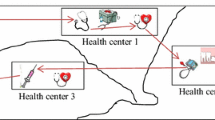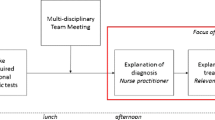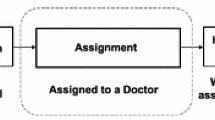Abstract
This paper introduces a deterministic model to plan the physician requirements for outpatient clinics to achieve service targets for the appointment lead-times of patients. The Ministry of Health of Singapore has established targets for the median, 95th percentile, and 100th percentile of appointment lead-times for patients, since long appointment postponements are regarded as being unacceptable for health care services. The study is to match the capacity of the healthcare providers to the patient demand for a re-entry system, subject to restrictions on the appointment lead-times for patients. We propose a mixed-integer programming model for planning capacity with the minimization of the maximum required capacity as its objective. In the model we assume a finite planning horizon, deterministic arrivals, multiple types of patients, identical physicians, and dependent demand between types of patients. We solve this model with a Branch and Cut algorithm. We test the model with numerical experiments using real data from the chosen specialty at the outpatient clinic of the studied hospital. The results show the value of the proposed model via a systematic push-pull mechanism in scheduling patients’ requests to minimize the objective. The clinic should use one of the appointment lead-time targets to determine the patients’ appointment dates. Finally, from the sensitivity analyses we demonstrate that the objective is negatively correlated with first-visit patients’ appointment lead-time targets, the discharge rates, and the re-visit patients’ mean appointment lead-time; we find a positive correlation between the first-visit patients’ mean appointment lead-time and the appointment lead-time targets.






Similar content being viewed by others
References
Bailey NTJ (1952) A study of queues and appointment systems in hospital out-patient departments, with special reference to waiting-times. J R Stat Soc 14(2):185–199
Bertsimas D, Tsitsiklis JN (1997) Introduction to linear optimization. Athena Scientific, Belmont, pp 272–278
Bowers J, Lyons B, Mould G, Symonds T (2005) Modelling outpatient capacity for a diagnosis and treatment centre. Health Care Manag Sci 8(3):205–211
Brahimi M, Worthington DJ (1991) Queueing models for out-patient appointment systems-a case study. J Oper Res Soc 42(9):733–746
Chakraborty S, Muthuraman K, Lawley M (2010) Sequential clinical scheduling with patient no-shows and general service time distributions. IIE Trans 42(5):354–366
Cote MJ (1999) Patient flow and resource utilization in an outpatient clinic. Socio Econ Plan Sci 33(3):231–245
Elkhuzen SG, Das SF, Bakker PJM, Hontelez JAM (2007) Using computer simulation to reduce access time for outpatient departments. Qual Saf Health Care 16(5):382–386
Green LV, Savin S (2008) Reducing delays for medical appointments: a queueing approach. Oper Res 56(6):1526–1538
Harper PR, Gamlin HM (2003) Reduced outpatient waiting times with improved appointment scheduling: a simulation modelling approach. OR Spectr 25(2):207–222
Hassin R, Mendel S (2008) Scheduling arrivals to queues: a single-server model with no-shows. Manag Sci 54(3):565–572
Ittig PT (1985) Capacity planning in service operations: the case of hospital outpatient facilities. Socio Econ Plan Sci 19(6):425–429
Kaandorp GC, Koole G (2007) Optimal outpatient appointment scheduling. Health Care Mana Sci 10(3):217–229
Klassen KJ, Rohleder TR (1996) Scheduling outpatient appointments in dynamic environment. J Oper Manag 14(2):83–101
Kourany RFC, Grarber J, Tornusciolo G (1990) Improving first appointment attendance rates in child psychiatry outpatient clinics. J Am Acad Child Adolesc Psychiatry 29(4):657–660
LaGanga LR, Lawrence SR (2007) Clinic overbooking to improve patient access and increase provider productivity. Decis Sci 38(2):251–276
Lakshmi C, Sivakumar AI (2013) Application of queueing theory in health care: a literature review. Oper Res Health Care 2(1–2):25–39
Liu L, Liu X (1998) Block appointment systems for outpatient clinics with multiple doctors. J Oper Res Soc 49(12):1254–1259
Muthuraman K, Lawley M (2008) A stochastic overbooking model for outpatient clinical scheduling with no-shows. IIE Trans 40(9):820–837
Pegden CD, Rosenshine M (1990) Scheduling arrivals to queues. Comput Oper Res 17(4):343–348
Qu S, Rardin RL, Williams JAS, Willis DR (2007) Matching daily healthcare provider capacity to demand in advanced access scheduling systems. Eur J Oper Res 183(2):812–826
Qu X, Shi J (2009) Effect of two-level provider capacities on the performance of open access clinics. Health Care Manag Sci 12(1):99–114
Qu X, Rardin RL, Williams JAS (2011) Single versus hybrid time horizons for open access scheduling. Comput Ind Eng 60(1):56–65
Rising EJ, Baron R, Barry B (1973) A systems analysis of a university-health-service outpatient clinic. Ann Oper Res 21(5):1030–1047
Sudhakar-Krishnan V, Rudolf MCJ (2007) How important is continuity of care? Arch Dis Child 92(5):381–383
Wijewickrama A., Tkakuwa S (2005) Simulation analysis of appointment scheduling in an outpatient department of internal medicine. Proceedings of the 37th winter simulation conference. Orlando
Zeng B, Turkcan A, Lin J, Lawley M (2010) Clinic scheduling models with overbooking for patients with heterogeneous no-show probabilities. Oper Res 178(1):1030–1047
Acknowledgments
The authors are grateful to Dr. Jamie Mervyn Lim of Tan Tock Seng Hospital, Singapore for providing us the opportunity to study this interesting field. The authors would like to thank the hospital’s administrators for providing data and necessary help to conduct this research.
Author information
Authors and Affiliations
Corresponding author
Appendix
Appendix
Rights and permissions
About this article
Cite this article
Nguyen, T.B.T., Sivakumar, A.I. & Graves, S.C. A network flow approach for tactical resource planning in outpatient clinics. Health Care Manag Sci 18, 124–136 (2015). https://doi.org/10.1007/s10729-014-9284-0
Received:
Accepted:
Published:
Issue Date:
DOI: https://doi.org/10.1007/s10729-014-9284-0




